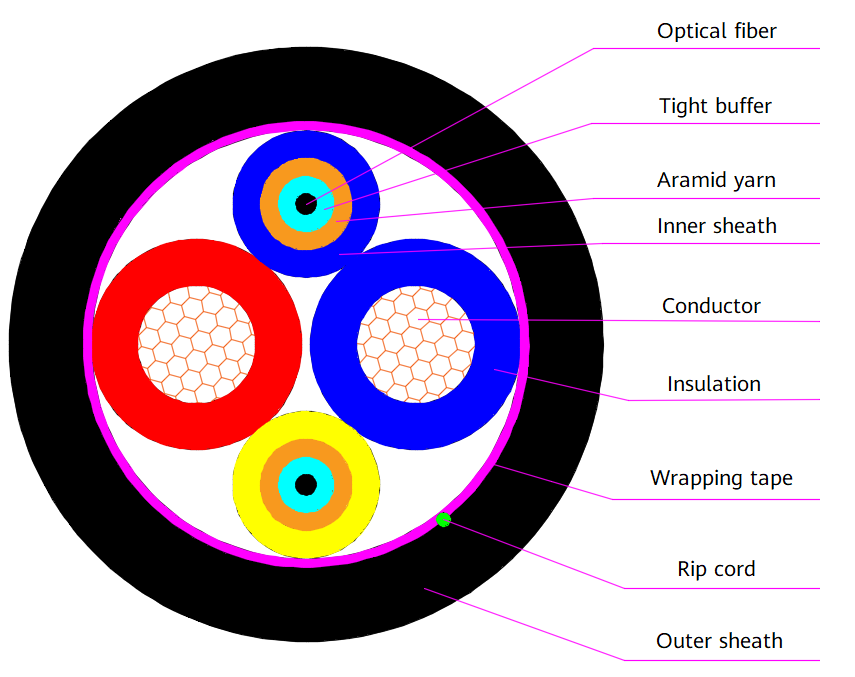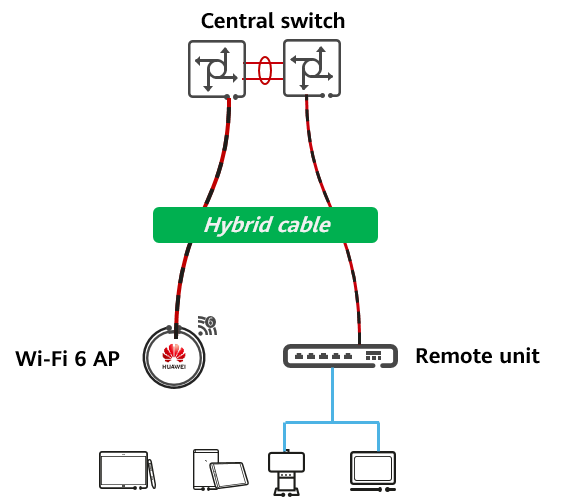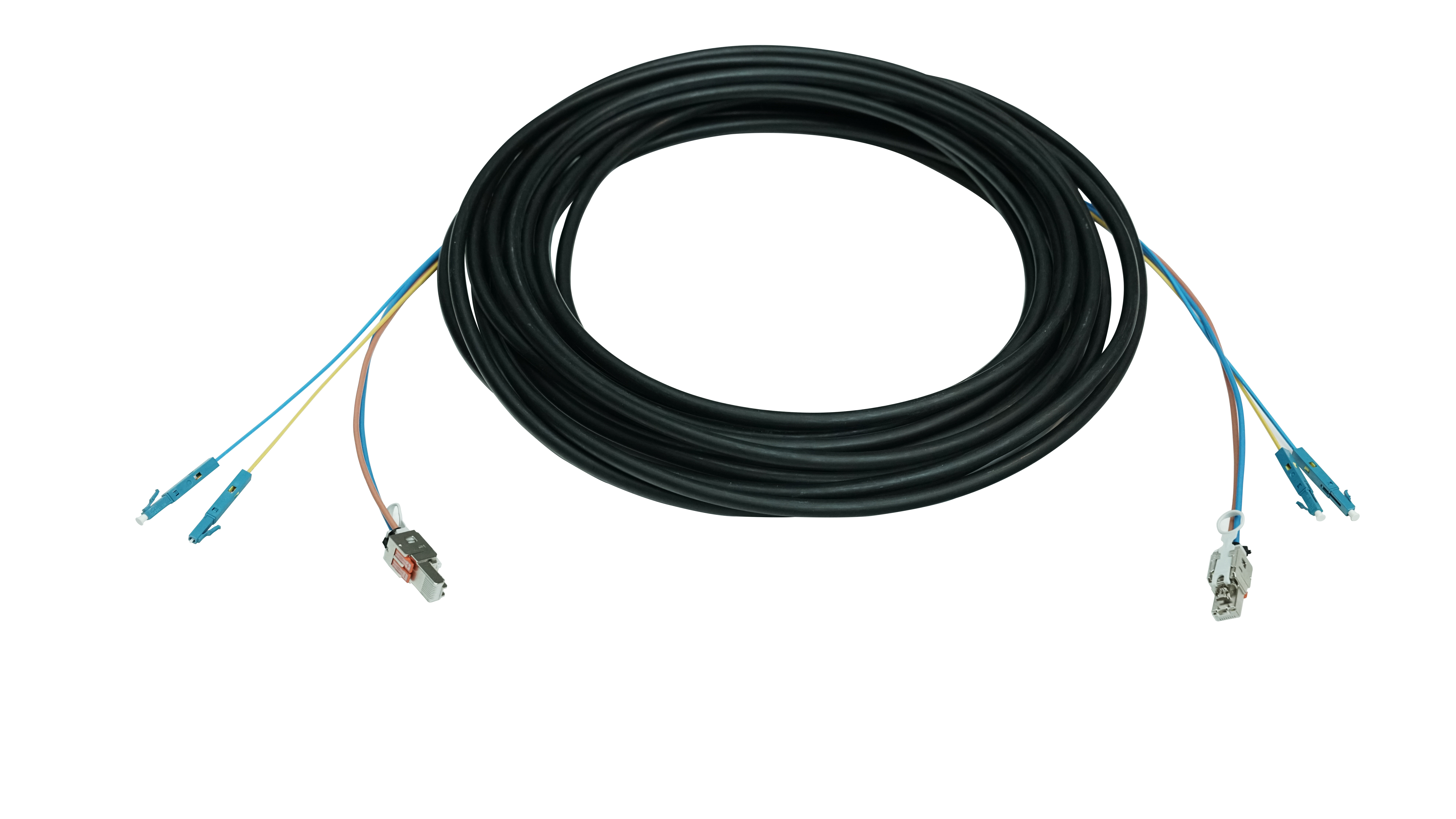What Is a Hybrid Cable?
A hybrid cable incorporates optical fibers and copper wires within the same jacket and is a medium for both power supply and data transmission. This is why hybrid cables are typically used to connect switches and APs or connect switches and remote units on campus networks. As future-proof WLAN technologies, such as Wi-Fi 6 and Wi-Fi 7, gain momentum, the conventional twisted pairs cannot keep pace with the bandwidth needs of these technologies. Not only this, optical fibers cannot be used for PoE power supply. This is where the hybrid cable comes in.
Why Do We Need Hybrid Cables?
To ensure normal operation of network services, cables between devices need to take on two responsibilities: power supply to devices and data transmission between devices. However, some network devices, such as WLAN APs, 5G base stations, and video surveillance cameras, need to be installed in complex environments where we can hardly find proper receptacles to supply power to them. To overcome this, one cable that can function as a medium for both power supply and data transmission becomes a must-have.
Typically, communication cables fall into optical cables and copper cables based on their transmission media. To elaborate, optical fibers are used most often as a means to transmit light based on total internal reflection, and have advantages such as large bandwidth, low loss, and long transmission distance. However, they are made of glass fibers that cannot conduct electricity, and therefore they cannot be used for PoE power supply. Copper cables consist of copper wires that transmit data via electromagnetic waves. As a good conductor of electricity and heat, copper cables can transmit both data and electrical signals, but will heat up rapidly in this process. This may lead to serious transmission loss, and therefore copper cables are not applicable to long-distance transmission. To prevent this, the regulation on network integrated cabling states that the total length of twisted pairs should not exceed 100 m. Facing this, we need to design a cable that can function as a medium for PoE power supply without hindering long-term bandwidth evolution. This is where the hybrid cable comes in.
A hybrid cable incorporates optical fibers and copper wires within the same jacket. It transmits data signals through optical fibers and transmits electrical signals through copper wires, enabling long-distance power supply while ensuring high-speed data transmission. In a word, this cable maximizes the advantages of both optical fibers and copper cables while minimizing their disadvantages. The following figure shows the cross section of a hybrid cable. Drawing on a special fiber-copper incorporation structure and a custom protective layer, the hybrid cable ensures that optical signals and electrical signals do not interfere with each other during transmission. Not only this, it can be deployed in various network systems, significantly reducing network engineering and construction costs.

Cross section of a hybrid cable
Where Can Hybrid Cables Be Used?
On campus networks, hybrid cables are typically used to connect APs or remote units to switches, as shown in the following figure. Conventionally, switches and APs are connected using twisted pairs, which can function as media for PoE power supply to APs and data transmission between switches and APs. However, as Wi-Fi technologies continue to develop, they pose increasingly higher requirements on cable performance. For example, as Wi-Fi 6 is commercially used on a large scale, it requires the cable to deliver up to 10 Gbit/s bandwidth. The future-oriented Wi-Fi 7 standards further require the cable to deliver a maximum of 40 Gbit/s bandwidth while supporting PoE power supply to APs over long distances. In most cases, APs are installed in complex environments and require PoE power supply over a distance of more than 100 m. In some special scenarios, the power supply distance will be much longer. For example, APs in some stadiums require 300 m or even longer power supply distances. The conventional twisted pairs, however, can only support PoE power supply over a distance of up to 100 m. All of this proves that hybrid cables are the best choice for connecting switches and APs.

Usage scenario of hybrid cables
If twisted pairs are used to connect switches and remote units, the data transmission distance must be within 100 m. This transmission distance is far from enough in some scenarios such as hotels, hospitals, and education institutions. If we use optical fibers to connect switches and remote units, how to supply power to remote units must be considered, which brings extra power deployment and management costs. In contrast, if hybrid cables are used, long-distance PoE power supply and high-speed data transmission can be achieved over such cables. In this case, remote units can be installed on user desktops rather than limited in weak-current rooms, significantly reducing cabling and management costs.
How Do Hybrid Cables Work?
As introduced above, a hybrid cable incorporates optical fibers and copper wires within the same jacket. It transmits data signals through optical fibers and transmits electrical signals through copper wires, enabling long-distance power supply while ensuring high-speed data transmission. You may be wondering why hybrid cables support long-term bandwidth evolution and long-distance PoE power supply, but twisted pairs and optical fibers do not.

Appearance of a hybrid cable
The answer falls into two parts:
First, the hybrid cable maximizes the advantages of optical fibers. It transmits data signals through optical fibers that are used most often as an optimal means to transmit data over long distances and at high bandwidth. In contrast, twisted pairs transmit data signals through copper wires, and the transmission quality is easily affected by the wire resistance and capacitance, inevitably leading to attenuation and distortion of data signals. Not only this, the extent to which data signals are attenuated is also related to the cable length. A longer cable usually means a higher attenuation value. To prevent this, the regulation on integrated network cabling states that the cabling distance of twisted pairs cannot exceed 90 m and the total link length cannot exceed 100 m. Data transmission over optical fibers, however, is not affected by resistance or capacitance. This is because they transmit data based on total internal reflection. In this process, we will not see energy loss due to the thermal effect of current, or crosstalk caused by electromagnetic induction. What we do see are longer transmission distance and higher bandwidth.
Second, the hybrid cable minimizes the disadvantages of copper wires. Copper wires in a hybrid cable transmit only DC electrical signals. This means that the power supply distance can be quite long. According to Huawei's tests, hybrid cables support 60 W PoE power supply even at a distance of 300 m. That said, copper wires still have resistance, and thermal effect still occurs during transmission, meaning there is still some energy attenuation. Therefore, the transmission distance over copper wires is limited even for DC electrical signals. Essentially, the transmission distance of a hybrid cable depends on the transmission distance of DC electrical signals over copper wires. But, as technologies and practices improve in the near future, we will see transmission distances reaching 1000 m or even farther, which will meet the requirements for long-distance PoE power supply in most scenarios.
How Do Hybrid Cables Evolve?
Hybrid cables fall into two generations based on their connector types: hybrid cable 1.0 and hybrid cable 2.0. As shown in the following figure, hybrid cable 1.0 provides separated optical-electrical connectors, while hybrid cable 2.0 provides integrated optical-electrical connectors.

Comparison between hybrid cable 2.0 and hybrid cable 1.0
Hybrid cable 1.0 occupies an electrical port and an optical port when being connected to a device. To elaborate, copper wires in such a cable need to be terminated by an RJ45 connector before being inserted into the electrical port, while optical fibers in the cable need to be terminated by a common LC connector before being inserted into a common commercial optical module on the optical port. The optical port transmits data, while the electrical port is responsible for PoE power supply. In contrast, hybrid cable 2.0 occupies just one hybrid optical-electrical port when being connected to a device. That is, the cable is fusion spliced with a pigtail or jumper with a PDLC connector before being inserted into a hybrid module on the hybrid optical-electrical port. The hybrid optical-electrical port is responsible for both data transmission and PoE power supply.
The biggest difference between hybrid cable 1.0 and hybrid cable 2.0 is that hybrid cable 2.0 can be connected to a hybrid optical-electrical port on a hybrid optical-electrical switch that enables separated optical and electrical ports to go integrated into one port. This optimization simplifies fusion splicing and usage of hybrid cables and doubles the density of optical and electrical ports. In the near future, hybrid cable 2.0 will take the domination.
- Author: Huang Mingxiang
- Updated on: 2023-11-28
- Views: 19125
- Average rating:







